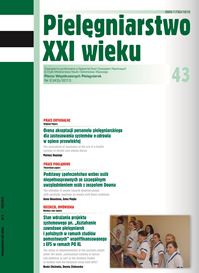Analiza interwencji zespołów ratownictwa medycznego w przypadkach nagłego zatrzymania krążenia w powiecie brzeskim w latach 2010–2012
Słowa kluczowe:
nagłe zatrzymanie krążenia, interwencje zespołów ratownictwa medycznego, resuscytacja krążeniowo-oddechowaAbstrakt
ANALIZA INTERWENCJI ZESPOŁÓW RATOWNICTWA MEDYCZNEGO W PRZYPADKACH NAGŁEGO ZATRZYMANIA KRĄŻENIA W POWIECIE BRZESKIM W LATACH 2010–2012
Cel pracy.Analiza interwencji zespołów ratownictwa medycznego w przypadkach nagłego zatrzymania krążenia w powiecie brzeskim w latach 2010-2012.
Materiał i metodyka. Badania retrospektywne zostały przeprowadzone w styczniu i w lutym 2013 roku. W badaniach wykorzystano analizę dokumentacji medycznej, którą stanowiły karty zlecenia wyjazdu zespołów ratownictwa medycznego, karty medycznych czynności ratunkowych oraz karty przebiegu resuscytacji. Analizą retrospektywną objęto dokumentację zespołów ratownictwa medycznego w powiecie brzeskim w latach 2010, 2011 i 2012. Analizie poddano 15600 kart wyjazdowych, z których wyodrębniono 177 kart, gdzie przyczyną interwencji było nagłe zatrzymanie krążenia. Analizowano tylko te przypadki, w których podjęto czynności resuscytacyjne. Wykluczono przypadki zgonów przed przybyciem zespołu ratownictwa medycznego.
Wyniki badań. Analiza dokumentacji wykazała, że ilość interwencji zespołów ratownictwa medycznego w przypadku nagłego zatrzymania krążenia w latach 2010 i 2011 była porównywalna. W roku 2012, odnotowano spadek ilości wyjazdów do tego rodzaju zdarzeń. Większość interwencji, była podejmowana przez zespoły specjalistyczne, co można tłumaczyć decyzją dyspozytora, który na podstawie przyjętego zlecenia, decydował o wysłaniu zespołu z lekarzem. Mediana czasu dojazdu ambulansu na miejsce zdarzenia, była zgodna z wymogami ustawowymi. Najmniej zdarzeń w analizowanym okresie, miało miejsce w godzinach nocnych. Nagłe zatrzymanie krążenia, częściej dotyczyło mężczyzn. Większość zdarzeń w latach 2010 i 2011 odnotowano w przedziale wiekowym 71-80, natomiast w roku 2012, w przedziale 61-70. Najczęstszą przyczyną zatrzymania krążenia były nagłe schorzenia kardiologiczne, najczęściej odnotowany mechanizm, w jakim doszło do zatrzymania krążenia, to asystolia. Postępowanie zespołów ratownictwa było zgodne z obowiązującymi wytycznymi postępowania resuscytacyjnego. Efektem większości skutecznych, podejmowanych przez zespoły ratownictwa medycznego działań, było przywrócenie krążenia. Niestety w większości przypadków, świadkowie zdarzenia, nie podejmowali czynności resuscytacyjnych.
Wnioski
1. Główną przyczyną NZK były choroby układu krążenia.
2. NZK częściej dotyczyło mężczyzn niż kobiet.
3. Do zatrzymania krążenia najczęściej dochodziło w domu chorego.
4. Niestety prawie 60% świadków zdarzenia nie podejmowało czynności resuscytacyjnych.
5. Efektem podejmowanych pomyślnie działań najczęściej było przywrócenie krążenia.
6. Udzielana przez zespoły specjalistyczne „S” i podstawowe „P” kwalifikowana pomoc, oparta była o obowiązujące standardy postępowania w NZK.
Bibliografia
1. Górecki A. Nagłe zatrzymanie krążenia – aktualne wytyczne postępowania resuscytacyjnego. Post Nauk Med. 2007;(2-3):87-97.
2. Rasmus A, Krawiec-Aleksandrowicz R, Krawiec K. Łańcuch przeżycia, Med Intens Ratunk. 2004; 7(2), 97-100.
3. Ustawa o Państwowym Ratownictwie Medycznym z dnia 8 września 2006. Dz. U. 06. Nr. 191, poz. 1410 z późniejszymi zmianami.
4. Ziółkowska K, Paciorek P. Czas dojazdu pogotowia ratunkowego na miejsce zdarzenia na przykładzie powiatu i miasta Słupsk. Probl Pielęg. 2009; 17(2):110 – 115.
5. Paczek K, Ratownictwo Medyczne – doświadczenia pierwszego roku. Anest Ratow 2007; 3: 151-152.
6. Kózka M, Kawalec E, Płaszewska-Żywko L. Analiza interwencji zespołu karetki pogotowia; Zdr Publ. 2008; 118 (1): 54-58.
7. Rasmus A, Krawczyk M, Balcerzyk-Bardzo E i wsp. Analiza postępowania resuscytacyjnego i ocena wpływu badanych czynników na przeżycie przedszpitalne i w pozaszpitalnych przypadkach zatrzymania krążenia na terenie łódzkiej aglomeracji miejskiej; Anest Intens Ter. 2004;(3):185-189.
8. Tamowicz B, Mikstacki A, Kalinowska M i wsp. Analiza przyczyn wezwań karetki reanimacyjnej w latach 2005-2006, Now Lek. 2008;(77, 6): 436-445.
9. Jałowiecki P, Rudner R, Willand M. i współ. Przyczyny i okoliczności niepodejmowania czynności resuscytacyjnych przez zespoły karetek reanimacyjnych i wypadkowych pogotowia ratunkowego, Med Intens Ratunk. 2004;7(1): 5-11.
10. Jankowski D, Czajkowski G, Jankowski A i wsp. Ocena wybranych czynników na skuteczność resuscytacji w nagłym zatrzymaniu krążenia poza szpitalem w materiale Oddziału Intensywnej Terapii i Anestezjologii Szpitala Wojewódzkiego im. M. Skłodowskiej-Curie w Szczecinie. Med Intens Ratunk. 2004; 7(4):187-194.
11. Pell JP, Sirel J, Mardsen AK et.al. Sex differences in outcome following community-based cardiopulmonary arrest. Eur.Heart. J. 2000; 21;239-244.
12. Piechocki J, Jakubaszko J. Ocena skuteczności zespołów ratownictwa medycznego w zagrożeniach sercowo-naczyniowych na obszarze wybranych dzielnic Wrocławia w okresie od 1.lipca 1998 r. do 31 grudnia 1999 r., Med Intens Ratunk. 2002, 5(4), 185-192.
13. Chęciński J. Ocena skuteczności postępowania przedszpitalnego w stanach nagłego zagrożenia życia na terenie miasta i województwa wrocławskiego. Med Intens Ratunk. 1998, 1, 7-13.
14. Jankowski P. Nagłe zatrzymanie krążenia poza szpitalem w populacji dorosłych miasta Szczecina w latach 2002-2003. Ann Acad Med Stetin. 2007, 53, 1, 33-42.
15. Rasmus A, Machała W, Samborska-Sabik A. Udział świadków w czynnościach resyscutacyjnych, Zdr Publ. 2002; 112 (4): 475-479.
16. Rasmus A, Czekajło MS. A national survey of the Polish population’s cardiopulmonary resuscitation knowledge. Eur. J. Emerg. Med. 2000; 7: 39-43.
17. Grześkowiak M. Szkolenie w zakresie postępowania w stanach zagrożenia życia w Europie i USA, Anest Ratow. 2007; 2: 99-104.
18. Bartczak M, Balcerzak-Barzdo E. Gotowość do udzielania pierwszej pomocy przed i po kursie BLS/ AED. Zdrowie Publiczne. 2011;(3):234-237.
19. Deakin ChD, Nolan JP, Soar J et al. Zaawansowane zabiegi resuscytacyjne u osób dorosłych – wytyczne resuscytacji 2010. www.prc.krakow.pl; 16.01.2013.
20. Andres J i wsp. Pierwsza pomoc i resuscytacja krążeniowo oddechowa. Polska Rada Resuscytacji. Kraków 2011.
21. Kózka M, Rumian B, Maślanka M. Pielęgniarstwo Ratunkowe. Warszawa: Wydawnictwo Lekarskie PZWL, 2013.
Pobrania
Opublikowane
Numer
Dział
Licencja
Prawa autorskie (c) 2013 Małgorzata Urbaniak-Ostrykiewicz, Beata Wilk-Łoboda (Autor)

Utwór dostępny jest na licencji Creative Commons Uznanie autorstwa 4.0 Międzynarodowe.




